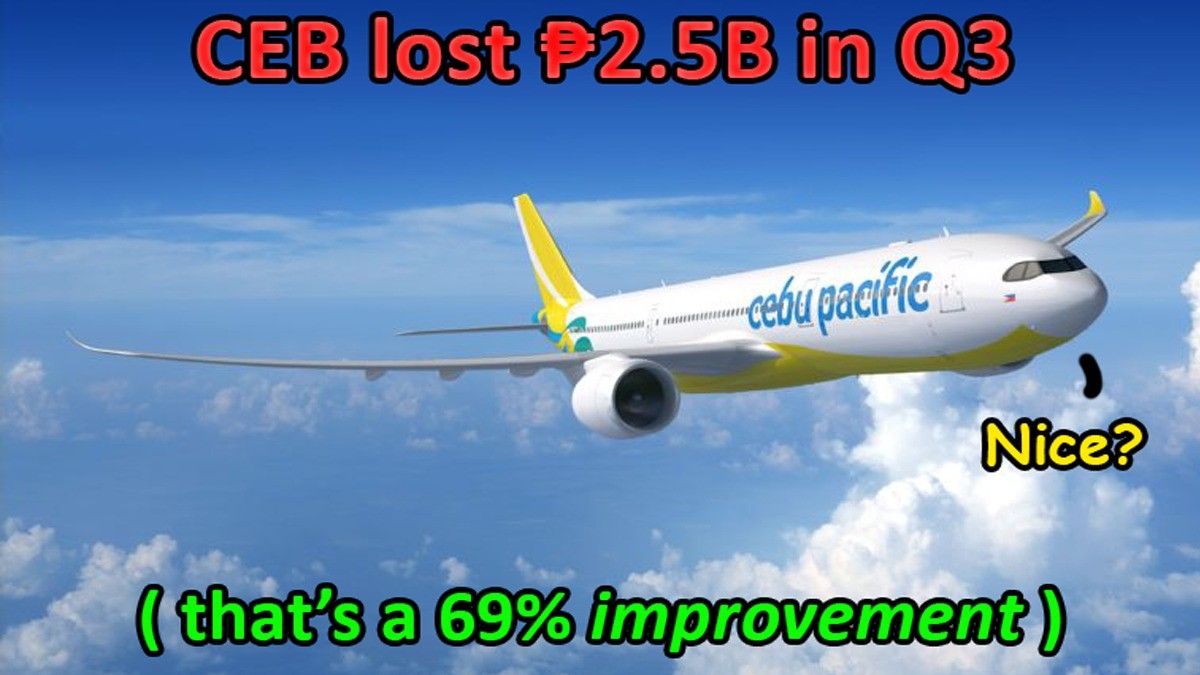Quick Take: Should we start cheering for Cebu Pacific's recovery? and 4 more market updates

Cebu Pacific [CEB 36.40 1.09%] [link] Q3 profit surged 68.97% y/y (down 35% q/q) to a net loss of P2.5 billion. 9M profit soared 45% y/y to a net loss of P12 billion. CEB reported that Q3 and 9M revenue “soared” as compared to 2021, with Q3 revenue up 419% y/y and 9M revenue up 310% y/y. CEB attributed this to a “significant increase in passenger volume, cargo services, and flight activities.” 9M passenger volume was up 450% to 10.4 million passengers, with load factor (fullness of airplanes) also increasing from 55.8% to 74.4%. CEB also noted a 22.1% increase in average fares, to P2,154/ticket.
MB Quick Take: I don’t like cheering recoveries relative to terrible depths of business performance from the lockdown years; it’s more instructive to compare against what a company was doing before COVID-19 and the administration’s lockdowns decimated economic activity. From that perspective, CEB’s Q3/19 earnings report shows that it reported a 9M/19 passenger volume of 16.7 million (61% higher than now), a load factor of 87% (17% higher than now), and an average ticket price of P2,794/ticket (30% higher than now). Getting rid of the lockdowns is cause for celebration for everyone, but it’s going to be a while for CEB to break even, let alone exceed previous levels of profitability. China is still locked down. Inflation is still rising. Cost of fuel is still high (up 201% as compared to 9M/19). Foreign exchange is still an issue (P3.8 billion in 9M/22 losses).
Converge [CNVRG 12.00 8.11%] [link] Q3 profit inched up 10.82% y/y (up 9% q/q) to P2.16 billion. 9M profit grew 17% y/y to P6.1 billion. CNVRG said that its big 30% jump in 9M revenue is attributed to a 30% growth in CNVRG’s residential business. CNVRG reported a 16% increase in residential customers y/y to 1.85 million, but that increase was only 1.5% over the customers CNVRG counted at the end of Q2. On the enterprise side, CNVRG reported a 65% increase in customers y/y, and 10% q/q. While CNVRG brought a significant number of new enterprise customers onboard, their ARPU (average revenue per unit) for those customers dropped 25% y/y to P11.430/month. ARPU for residential subscribers dropped 6% y/y to P1.261/month.
MB Quick Take: The honeymoon period is over. After a dominant 165% rise from P15/share to P40/share between its IPO and October of 2021, CNVRG has given that all back and then some, falling 70% from that peak to the P12/share level. It was unceremoniously dumped by its American equity investor; those hasty block sales spooked investors. Revenue is increasing, but at a slower rate. Customers are increasing, but at a much slower rate. Absolute profits are increasing, but per-user profitability is falling. Did CNVRG speed-run its hypergrowth stage backed by the demand for landlines during the lockdowns? Did the company already catch all the big fish in the pond, and the falling profitability is the natural result of padding user stats with cheaper plans and promotions? What will happen to these stats in a couple of quarters if Starlink actually starts offering its satellite broadband services to Philippine clients? Dennis “Pampanga Dennis” Uy has a lot to think about.
Philippine Statistics Authority (PSA) [link] said that gross domestic product (GDP) growth in Q3 was 7.6%, beating the widely-held 6.0% estimate by analysts. It’s also slightly higher than Q2’s 7.5% growth (which was upwardly adjusted twice). Socioeconomic Planning Secretary Arsenio Balisacan threw some cold water on the news, saying that while the results were “remarkable”, our country “still faces a considerable burden in the form of high inflation due to heightened external risks and the brunt of recent typhoons.”
MB Quick Take: The key takeaway here is that, despite everything that’s been happening (rising costs of food, rising costs of fuel, rising interest rates, storms, etc), the domestic consumption economy is actually showing signs of health. Improving health. The signal this sends to BSP Governor Felipe Medalla is that the economy can handle more rate raises. It’s not like the BSP has been coy about raising rates since Mr. Medalla took over from Mr. Diokno, but this kind of result should only provide Mr. Medalla with more encouragement/cover to raise as much as he might need. Whether that will be enough to save the peso from breaching that P60:$1 barrier established by the administration remains to be seen.
Bank of Commerce [BNCOM 8.00] [link] Q3 profit ballooned 87.2% y/y (up 14% q/q) to P602 million. 9M surged 148% y/y to P1.49 billion. BNCOM attributes the increased performance to higher interest income (+19% y/y to P3.8 billion), forex gains (+470% y/y to P114 million), and higher fees and commissions (+43% y/y to P550 million).
MB Quick Take: The San Miguel [SMC 96.85 0.36%] affiliate recently received its license to operate as a universal bank, which will allow it to operate outside the SMC ecosystem for the first time, so it will be interesting to see how that development impacts earnings and performance in Q4 and the rest of 2023. All banks are doing fine right now, it seems, to the point where it’s almost commonplace to see banks posting 100% profitability gains over similar time periods from last year. Still, despite BNCOM’s focus on small and medium-sized companies, the same thought I’ve had with other banks persists here: at what point will rising interest rates clip profits and turn negative for banks as demand for loans falls and borrowers struggle to make payments? Feels like we won’t start to feel this until Q1 or Q2 of next year.
Raslag [ASLAG 1.66 2.35%] [link] declares a P0.0334 dividend, payable on December 22 to shareholders as of December 8, out of unrestricted retained earnings from 2021. The dividend implies a yield of 2% relative to ASLAG’s current price, and 1.7% relative to its IPO price of P2.00/share.
MB Quick Take: I had a few people contact me, confused about whether ASLAG was a REIT, and asking if ASLAG’s estimated yield is good enough relative to other REITs in the sector. The quick answer is that, no, ASLAG is not a REIT, and that its yield isn’t comparable to any of the REITs on the exchange. This dividend was declared around the time that the REITs will declare their Q3 quarterly dividends, but the important difference here is that this is ASLAG’s full-year dividend for 2021. It’s not a quarterly dividend, but it’s still nice for the Nepomuceno Family and ASLAG’s shareholders to get a little pre-Christmas cash.
--

Merkado Barkada's opinions are provided for informational purposes only, and should not be considered a recommendation to buy or sell any particular stock. These daily articles are not updated with new information, so each investor must do his or her own due diligence before trading, as the facts and figures in each particular article may have changed.
- Latest


























